
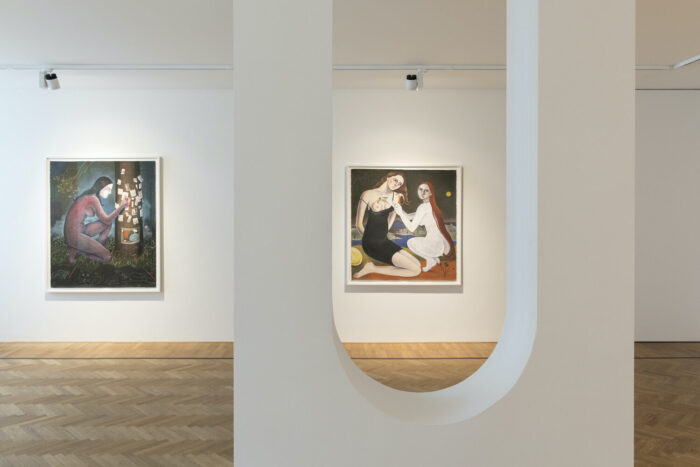


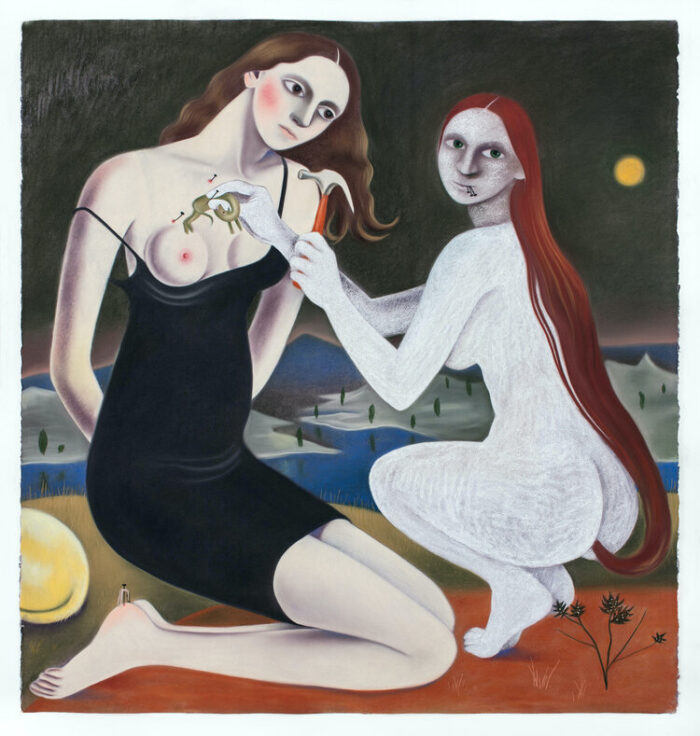
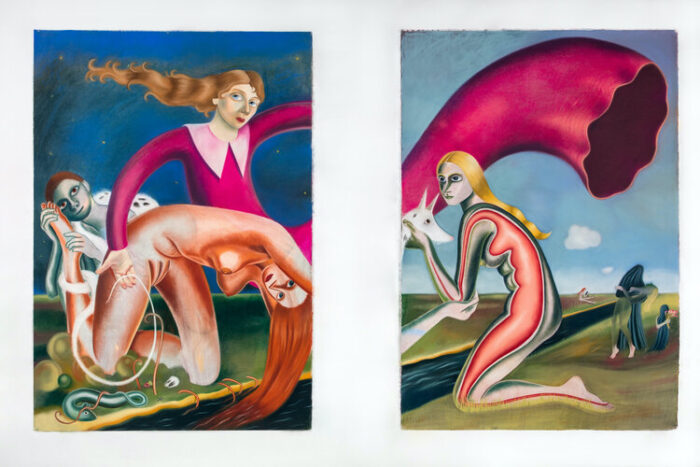
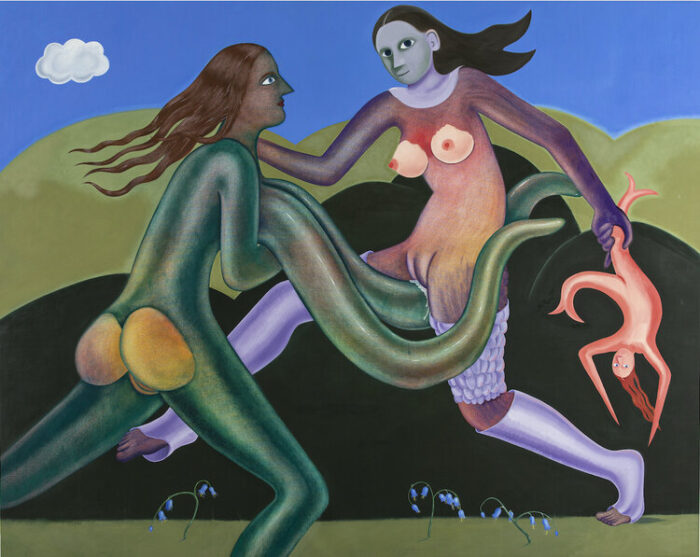
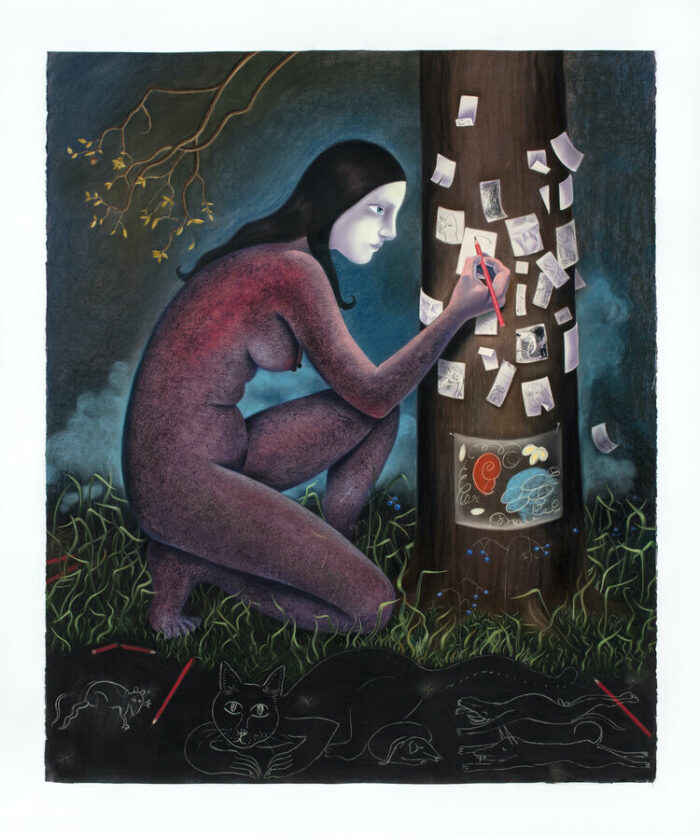
Sara Anstis: Pencil of Rays at Galerie Fabian Lang, Zürich
7 May – June 12,2021
All Images courtesy of Galerie Fabian Lang
Galerie Fabian Lang presents Sara Anstis: Pencil of Rays . The exhibition consists of works that have been created over the past six months and is the largest exhibition to date by the young Swedish-Canadian artist.
In Anstis’ lively, otherworldly paintings, strong women cavort under wide skies. They lazy in the sun, they read, paint or sleep, they torture or make love. They interact with nature and various animals, mostly bizarrely distorted dogs, mermaids and octopuses.
A few years ago they were mostly romping around the sea, naked, young and bald, their vulvae and breasts enlarged, as if they wanted to emphasize the pleasure in their bodies, the possibilities of sexual satisfaction. Recently, however, when the human element has been awakened, their hair and their bodies have started to grow and they are moving more inland. They even got some clothes. Sometimes the figures have a rather unusual number of limbs or long, tubular breasts – in the pictures a woman seems to be able to transform herself into a tentacle at any moment, just as easily as she could ride a bike or read a book. But the danger is often only a breath away: horror is only hinted at in fragments, it seems to be hidden in the half-forgotten vestiges of dreams.
Anstis’ new pictures, including mainly works with soft pastel chalk on paper and occasionally on canvases, are highly topical with their complexity, their detail and their metamorphic quality. At the same time, however, there are plenty of allusions and references – to art history, to fables and myths. Ovid’s Metamorphoses and paintings such as Jean Fouquet’s Diptych by Melun (1445) with the solid, moon-shaped breasts of his Madonna provide inspiration ; Jean-Honoré Fragonard’s Le Souvenir (1778), in which a young woman carves her lover’s initials into tree bark; Carol Rama’s Movimento e immobilità di Birnam (1977), in which bicycle tubes are attached to the image of a forest; and Paulo Uccello’sNiccolò Mauruzi da Tolentino at the Battle of San Romano (c. 1438–1440), a claustrophobic landscape, densely populated by fighting men and horses. As different as they may seem, if you just look at them long enough, the similarities between the different images crystallize – above all the impression that the realism here has been destroyed in favor of increased mood, feelings and atmosphere. Colors sing a strange song, communication becomes complicated, landscapes are as sensual as bodies, but the bodies themselves are strange vehicles.
For example, in The Drawer (2021), a lonely woman draws on paper attached to a tree; the dark night is lit by the white glow of her face. The artist reverses Fragonard’s painting by replacing the lover’s initials with intimate drawings: the focus shifts to the inner life of the woman. Uccello’s picture also serves as a reference, the broken spears of the soldiers are turned into pencils.
Anstis’ first and greatest love is soft pastel chalk on heavy paper. She looks at the material like a skin: paper “remembers and shows its history”. After she has covered her base with a colorful primer, she works the pigment into the paper with her fingers: lines become sharper, shapes become blurred, colors increase to an intoxicating intensity. The bodies of women are formed from the layers of pigment that the artist rubs in, and the skin is polished to a shine; Landscapes shimmer in the background like flickering illusions, like feverish dreams.
The artist skillfully creates scenes in which playful humor is subdued by the seemingly immediate violence – she plays with the appeal of intruding into a private sphere. Last year, when she too suffered from the loneliness enforced by the pandemic, Anstis moved her women from the sea to a new landscape, inside, close to the earth. In this new place the women deal with how they can live in new ways: with themselves and with each other, with nature, but also with books and pens – objects that have acquired a new meaning during their long isolation.
